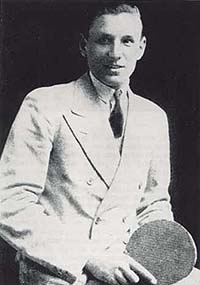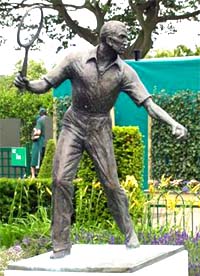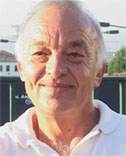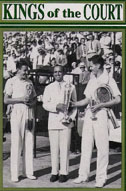Fred Perry:
The Last English Champion
By Ed Atkinson
 |
World champion: in table tennis and then tennis. |
Fred Perry became the world table tennis champion at 19, and then looked for a new realm to conquer. And conquer he did. A paragon of speed and style, he became the number one player in the world, and stayed there for four years, from 1934 to 1938.
Perry was the first man ever to win all four majors titles, though not in the same year. Now over 70 years later, he remains the youngest to achieve that feat, at the age of 26.
Perry played with a continental grip with part of his hand on top of the handle, and pressured his opponents by taking the ball early, giving them less time to react.
Jack Kramer described the experience of playing him this way: "He rushed me right off the court the first time I ever got on the court with him. I could hardly get my breath he rushed me so much.
"And so the next time I said, "Well, I'll be ready for him this time." I was a little more ready but the same thing happened again. It took me about three matches or four to play against Fred before I finally could hold my own with him."
Two outstanding things about Perry his his mental strength and his physical stamina. In 1926 he came back from 4-1 to beat Don Budge 8-6 in the 5th set in the finals of the U.S. Championship, completing his personal Grand Slam.
Pancho Segura described Perry's tenacity this way: "He never threw a set. He always felt that if he kept you out there longer, it was better for him. Tremendous condition, tremendous running ability. Great, great concentration."
"Wonderful speed around the court, as fast as anybody ever. He could cover the court like a blanket, his running forehand was fantastic and he was a really good volleyer."
Continued Segura: "Perry's one of the few players that I ever knew that could play the fifth set as fresh and as strong as the first set. Kramer couldn't do it. Gonzalez couldn't do it. I don't know of any players that were as strong in the fifth set as Fred Perry was."
"A first-class all-around player and really tough when he would get the upper hand.
He was ruthless. As soon as he would get the upper hand, he would pressure, pressure, pressure
and just kind of lord it over you."
Although much has been made of the swinging volley, this was actually a shot that
Fred Perry had mastered in the 1930s.
As Jack Kramer explained: "Whenever an opponent would make an especially good
shot, Perry would cry out 'Very clevah.' I never played Fred competitively, but I heard from
other guys that hid 'Very clevah' drove a lot of opponents crazy."
Perry could have become the first player to capture the Grand Slam in a calendar
year--except for a little-known Italian named Giorgio Di Stefani whom he met in an early round
of the French Open.
Di Stefani was very unorthodox but very good on clay. He had no backhand--literally.
Instead he was ambidextrous, switching the racquet from hand to hand and hitting forehands on both
sides.
Perry had injured a leg and knew he couldn't win. Instead of defaulting, he asked
Giorgio on the changeover not to make him look bad. The Italian however, took full advantage of
Perry's injury and drop shotted his way to a blowout. As they shook hands, Perry calmly said,
"Oh all right Giorgio, you won't get a game the next time we meet."
The next time was in the Australian Championships of 1935. Perry was a man of his
word, winning the match 6-0, 6-0, 6-0, and finishing it off with his distinctive victory leap
over the net.
After three years as the World No. 1 player while still an amateur, Perry turned
professional in 1937. For the next two years he played lengthy tours against the powerful American
player Ellsworth Vines. In 1937 they played 61 matches in the United States, with Vines winning
32 and Perry 29. They then sailed to England, where they played a brief additional tour. Perry
won 6 matches out of 9
 |
A champion who hindered English tennis for decades? |
Most observers at the time considered Perry to be the World No. 1 for the fourth
year in a row, sharing the title, however, with both Vines and the amateur Don Budge. The
following year, 1938, the tour was even longer, and this time Vines beat Perry 49 matches to 35.
But in 1939 Budge turned professional and played a series of matches against both Vines and Perry,
beating Vines 21 times to 18 and dominating Perry by 18 victories to 11.
Today Perry is mainly remembered as the last Englishman to win Wimbledon, immortalized by the bronze statue on the Wimbledon grounds. Ironically, some experts feel that Perry's success actually hindered the subsequent development of generations of English players, due to his continental forehand.
Said Jack Kramer: "Perry was a physical freak with the way he could hit a
forehand -- snap it off like a ping-pong shot. Nobody else could be taught to hit a shot that
way. But the kids in England copied Perry's style, and it ruined them. Even after Perry faded
out of the picture, the coaches there kept using him as a model."





